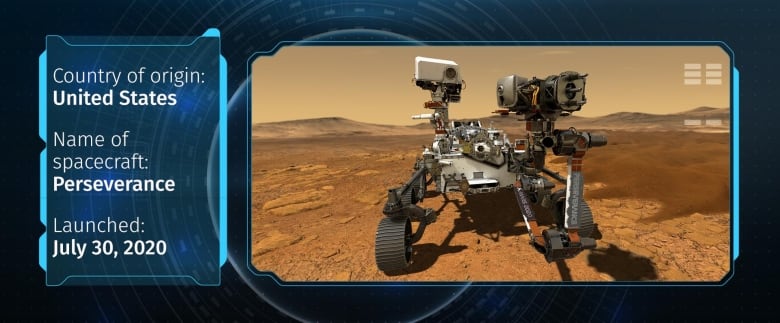It's a big day for space exploration.
NASA's mission controllers are expecting to confirm the Perseverance rover's landing on the surface of Mars at 3:55 p.m. ET today.
After hitting the top of the planet's atmosphere, Perseverance will then make the difficult trip onto the surface of Mars, a voyage many spacecraft before it have failed to do.
"Landing on a planet that's so far away is very technical," said Sara Mazrouei, a planetary scientist and educational developer at Ryerson University in Toronto.
"It depends a little bit on luck and a lot on science and technology."
If successful, the American rover will join two other spacecraft that recently entered Mars's orbit: the Amal space probe from the United Arab Emirates and China's Tianwen-1 rover and orbiter duo.
The three spacecraft all launched within days of each other last July to take advantage of the close alignment of Earth and Mars, resulting in their close arrival times.
Landing on the Red Planet
The United States, the only country to safely put a spacecraft on Mars, is seeking its ninth successful landing on the planet, which has proved to be the Bermuda Triangle of space exploration.
Since 1960, more than half of the world's 45 missions there burned up, crashed or otherwise ended in failure, according to information from the U.S. National Aeronautics and Space Administration.
"You're sending something toward a moving target where both the rover and Mars are moving in different directions, and you're trying to land inside, basically doing a hole in one," said Tanya Harrison, director of science strategy with Earth-imaging company Planet Labs.
But she said improvements in technology could point to success for the rover.
"The thing that Perseverance has that none of the other rovers have had before is what we call the Terrain Relative Navigation system," said Harrison, who has been involved in several of NASA's Mars missions — including work on Perseverance's "zoomable eyes," which will take colour pictures of the landscape around the rover.
The Washington-based planetary scientist said the navigation system will warn the rover of any hazards, such as a pointy rock, and alter its landing course.
Its sky crane touchdown system will also soften the blow of landing on the Red Planet.
"So that plus the fact that we've used the sky crane before on Curiosity, I think we shouldn't have any problems," Harrison said, referring to the Curiosity rover, which was launched from Cape Canaveral, Fla., in November 2011 and landed on Mars in August 2012.
Perseverance's mission
The car-sized vehicle is the biggest, most sophisticated Mars rover ever built.
The plutonium-powered, six-wheeled rover will drill down and collect tiny geological specimens that will be brought home in about 2031, in a sort of interplanetary relay race involving multiple spacecraft and countries.
Perseverance will aim for treacherous unexplored territory on Mars: Jezero Crater, a dusty expanse riddled with boulders, cliffs, dunes and possibly rocks bearing signs of microbes from what was once a lake more than three billion years ago.

The rover will store 15-gram rock samples in dozens of super-sterilized titanium tubes.
The plan is for NASA and the European Space Agency to launch a dune buggy in 2026 to fetch the rock samples, along with a rocket ship that will put the specimens into orbit around Mars.
Then another spacecraft will capture the orbiting samples and bring them home.
Samples brought back from Mars, not drawn from meteorites discovered on Earth, have long been considered "the Holy Grail of Mars science," said NASA's original and now-retired Mars czar, Scott Hubbard.
To definitively answer the profound question of whether life exists — or ever existed — beyond Earth, the samples must be analyzed by the best electron microscopes and other instruments, which are far too big to fit on a spacecraft, he said.
But before any of that can happen, the landing on Mars needs to go smoothly on Thursday, a win many people could use right now, Ryerson University's Mazrouei said.
"I'm really looking forward to a successful landing to give us some hope, to remind us of what us humans are capable of achieving and to give us hope globally," she said.
"I'm really looking forward to that."
https://news.google.com/__i/rss/rd/articles/CBMiSWh0dHBzOi8vd3d3LmNiYy5jYS9uZXdzL3RlY2hub2xvZ3kvbmFzYS1wZXJzZXZlcmFuY2Utcm92ZXItbWFycy0xLjU5MTc3NzLSASBodHRwczovL3d3dy5jYmMuY2EvYW1wLzEuNTkxNzc3Mg?oc=5
2021-02-18 09:00:00Z
52781383820654
Tidak ada komentar:
Posting Komentar